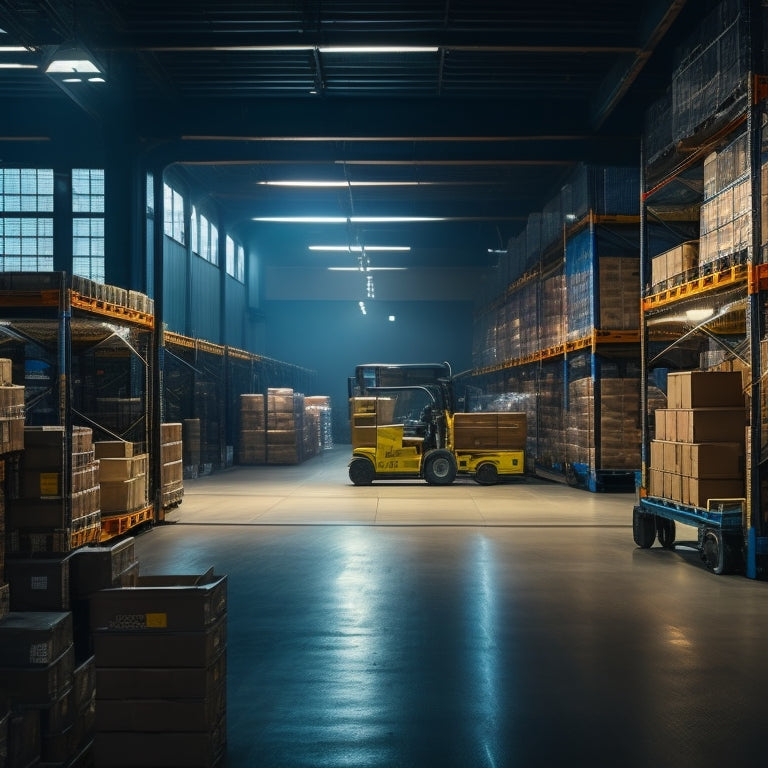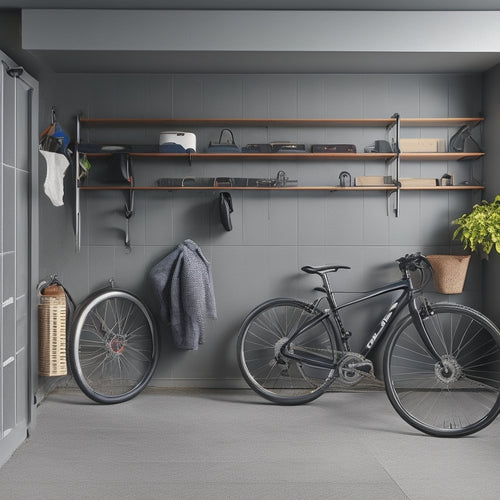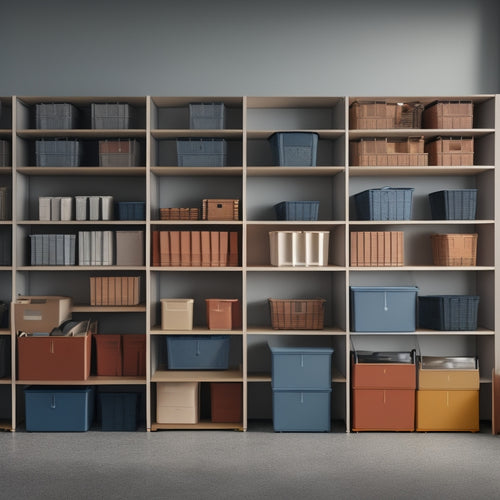
Mobile Shelving Costs for Warehouses
Share
As you consider mobile shelving for your warehouse, you'll want to know the costs involved. Factors like design options, material choices, weight capacity, and layout considerations will impact the overall cost. On average, basic mobile shelving units cost between $500-$1,000, while high-capacity units can range from $5,000-$10,000. Customized solutions can optimize space and productivity, but it's crucial to evaluate market trends and long-term benefits. By understanding the costs and benefits, you'll make an informed investment decision that maximizes your warehouse's potential - and you're just getting started on understanding the full scope of mobile shelving costs and benefits.
Key Takeaways
- Mobile shelving costs range from $500 to $10,000 per unit, depending on design options, material choices, and weight capacity.
- Factors influencing costs include layout considerations, safety compliance, and weight capacity, which impact overall strength and stability.
- Customized mobile shelving solutions can optimize space and productivity, but require careful planning and material selection.
- Installation and maintenance costs, including professional assistance and regular cleaning, should be factored into the overall budget.
- A thorough cost analysis, including ROI and payback period evaluation, is essential to ensure the best value for investment in mobile shelving.
Understanding Mobile Shelving Systems
In relation to optimizing storage capacity, mobile shelving systems have proven to be a highly effective solution for various industries. You can maximize your warehouse's storage potential by installing these systems, which are designed to provide efficient use of floor space.
Mobile shelving benefits include increased storage capacity, improved inventory management, and enhanced productivity. These systems typically feature mobile carriages that move along tracks, allowing you to access stored items with ease.
When considering mobile shelving systems, you'll want to evaluate the mobile shelving features that matter most to your operations. Look for systems with durable construction, adjustable shelving, and secure locking mechanisms to guarantee the safety of your staff and inventory.
Additionally, consider the weight capacity and dimensions of the system to guarantee it can accommodate your specific storage needs. By understanding the benefits and features of mobile shelving systems, you can make an informed decision about whether this solution is right for your warehouse.
Factors Affecting Mobile Shelving Costs
Evaluating mobile shelving costs requires reflecting on several key factors that impact the overall expense of these systems.
You'll need to think about design options, such as the type of shelving and the number of levels, as well as material choices, like steel or aluminum. The weight capacity of the shelving is also essential, as it affects the system's overall strength and stability.
Layout considerations, including the aisle width and shelf depth, are also significant. Accessibility features, like ADA-compliant walkways, may be necessary for certain facilities.
Don't forget to take into account safety standards, such as OSHA guidelines, and the environmental impact of the system. Long-term durability is also vital, as it affects maintenance and replacement costs.
Additionally, user training and technology integration, like automated inventory management systems, can impact the overall cost. By carefully evaluating these factors, you can get an accurate estimate of your mobile shelving costs and make an informed decision for your warehouse.
Calculating Warehouse Space Savings
Your warehouse's floor plan is a significant resource, and calculating warehouse space savings is essential to maximize its efficiency. By optimizing your storage space, you can improve inventory management, reduce costs, and enhance overall workflow.
To calculate space savings, start by analyzing your current layout and identifying areas of inefficiency. Consider factors like storage density, aisle width, and product categorization to optimize your layout planning.
Next, assess your inventory management processes to determine how often items need to be accessed and how much space is required for each item. This will help you design a layout that balances accessibility with storage capacity.
Additionally, consider safety considerations, such as emergency exit routes and fire suppression system access. By calculating warehouse space savings, you can identify opportunities for workflow improvement, increase capacity planning, and achieve design flexibility.
Mobile Shelving Vs Static Shelving
Maximizing warehouse space efficiency often boils down to the type of shelving system you use.
You'll want to evaluate the benefits of mobile shelving versus traditional static shelving. When you opt for mobile shelving, you can increase storage capacity by up to 85% compared to traditional static shelving. This is because mobile shelving units are compact and can be easily relocated to create additional aisle space when needed.
Here are three key advantages of mobile shelving over static shelving:
-
Space savings: Mobile shelving allows you to store more inventory in a smaller footprint, reducing the need for additional warehouse space.
-
Improved accessibility: With mobile shelving, you can easily access stored items without having to maneuver through narrow aisles or remove items from shelves.
-
Enhanced safety: Mobile shelving reduces the risk of accidents caused by tripping over or knocking over shelves, creating a safer work environment.
Static shelving, on the other hand, can lead to wasted space, increased labor costs, and reduced productivity.
Average Mobile Shelving Unit Costs
You've made the decision to invest in mobile shelving, but now it's time to crunch the numbers. Understanding the average cost of a mobile shelving unit is vital for a successful implementation.
The cost of mobile shelving units can vary greatly depending on factors such as size, material, and features. Here's a breakdown of the average costs for different types of mobile shelving units:
| Type of Mobile Shelving | Average Cost per Unit | Capacity |
|---|---|---|
| Basic Mobile Shelving | $500-$1,000 | 100-200 lbs |
| Mid-Range Mobile Shelving | $1,500-$3,000 | 500-800 lbs |
| High-Capacity Mobile Shelving | $5,000-$10,000 | 1,000-2,000 lbs |
When comparing costs, it is important to evaluate market trends and the long-term benefits of mobile shelving, such as increased storage capacity and improved safety. By doing a cost comparison, you can confirm you're getting the best value for your investment.
Customized Mobile Shelving Solutions
Taking into account the unique storage needs of your facility, a customized mobile shelving solution may be necessary to optimize space and productivity. A custom design allows you to tailor the system to your specific requirements, guaranteeing maximum efficiency and effectiveness.
When opting for a customized solution, you'll want to contemplate the following key factors:
-
Space optimization: Confirm the system is designed to maximize storage capacity while maintaining user accessibility and ease of maneuvering.
-
Material selection: Choose materials that meet your facility's specific needs, such as durability, corrosion resistance, or special finishes.
-
System adaptability: Select a system that can adapt to changing storage needs, such as adjustable shelves or modular components.
Additionally, you'll want to reflect on aesthetic considerations, load capacity, and safety standards to verify the system meets your facility's needs and complies with regulations.
By integrating technology, such as automated inventory tracking, you can further enhance the system's functionality.
Installation and Maintenance Costs
As you prepare to implement your customized mobile shelving solution, it's vital to factor in the installation and maintenance costs that will guarantee a seamless and efficient operation.
You'll want to take into account the installation techniques that'll assure a safe and secure setup. This may include hiring a professional team or training your staff on proper installation procedures.
Additionally, you'll need to establish maintenance schedules to prevent equipment failure and guarantee peak performance. Regular checks will help identify potential issues before they become major problems.
Maintenance costs will vary depending on the complexity of your system and the frequency of use. You should budget for regular cleaning, lubrication, and replacement of worn parts.
It's also essential to have a plan in place for emergency repairs to minimize downtime and reduce the risk of accidents.
ROI and Payback Period Analysis
How quickly will your mobile shelving solution pay for itself? When evaluating an investment in mobile shelving, understanding the return on investment (ROI) and payback period is essential for investment justification.
To calculate the ROI, you'll need to determine the total cost of the mobile shelving system, including installation and maintenance costs, and compare it to the benefits it provides, such as increased storage capacity, reduced labor costs, and improved efficiency metrics.
Here are three key factors to evaluate when assessing the payback period of your mobile shelving investment:
-
Labor cost savings: Calculate the reduction in labor costs resulting from increased efficiency and productivity.
-
Increased storage capacity: Determine the value of the additional storage space gained from the mobile shelving system.
-
Extended equipment life: Take into account the extended lifespan of your equipment and the resulting cost savings from reduced replacement and maintenance needs.
Budgeting for Mobile Shelving Projects
When budgeting for a mobile shelving project, you'll need to assess your project needs, including the type and quantity of materials to be stored, to determine the necessary storage capacity.
You'll then need to calculate the storage capacity required to guarantee your system meets your needs.
Assessing Project Needs
Before diving into a mobile shelving project, you need to define your requirements and assess the scope of work to create an accurate budget. This involves understanding your project goals, space requirements, and inventory types.
You'll also need to conduct a workflow analysis to identify bottlenecks and areas for improvement.
To get started, consider the following key factors:
-
Space and inventory analysis: Determine the maximum storage capacity you need and the types of inventory you'll be storing. This will help you choose the right mobile shelving system and guarantee it meets your needs.
-
Budget and timeline constraints: Establish a realistic budget and timeline for your project. This will help you prioritize your needs and make informed decisions about your mobile shelving system.
-
Safety and design considerations: Think about safety considerations, such as aisle width and lighting, as well as design preferences, like color schemes and branding.
You'll also want to guarantee equipment compatibility and future scalability.
Calculating Storage Capacity
As you investigate calculating storage capacity, keep in mind that accurately determining your storage needs is vital to selecting the right mobile shelving system and staying within budget.
You'll need to evaluate shelf dimensions, load capacity, and aisle width to guarantee your system can handle the weight and volume of your inventory. Material selection is also important, as it affects weight distribution and system compatibility. A well-designed layout will enhance storage capacity while meeting accessibility requirements and safety standards.
To calculate storage capacity, you'll need to analyze your inventory management needs. Reflect on the types and quantities of items you'll be storing, as well as how often they'll need to be accessed. This will help you determine the best shelf configuration and layout design.
Additionally, think about factors like floor space, ceiling height, and any obstacles that may impact your system's design. By carefully calculating your storage capacity, you can assure a mobile shelving system that meets your needs while maintaining a safe and efficient work environment.
Estimating Installation Costs
You've likely invested significant time and effort into calculating your storage capacity and designing your mobile shelving system.
Now, it's crucial to estimate the installation costs to guarantee a smooth and budget-friendly project.
Estimating installation costs involves considering several factors, including:
-
Labor requirements: The number of workers needed to complete the installation, their skill levels, and the hours required to finish the job.
-
Installation timeline: The duration of the installation process, including preparation, assembly, and testing.
-
Site preparation: Any necessary modifications to the warehouse floor, such as leveling or anchoring, to guarantee a safe and secure installation.
A thorough understanding of these factors will help you create a realistic budget and timeline for your mobile shelving project.
Be sure to consult with a professional installer or supplier to get accurate estimates customized to your specific needs.
Frequently Asked Questions
Can Mobile Shelving Systems Be Used in Cold Storage Facilities?
You can definitely use mobile shelving systems in cold storage facilities, as they're designed to withstand freezing temperatures and provide efficient storage while maintaining temperature control, ensuring the cold storage benefits you need for your sensitive products.
Are Mobile Shelving Units Compatible With Existing Warehouse Management Software?
You'll likely face integration challenges, but most mobile shelving units are designed to be software compatible, so you'll need to verify the system's API and guarantee seamless integration with your existing warehouse management software to avoid operational disruptions.
Do Mobile Shelving Systems Meet OSHA and Safety Regulations?
You guarantee a safe working environment by selecting mobile shelving systems that meet OSHA and safety regulations, adhering to strict safety standards and compliance requirements, assuring a hazard-free warehouse operation that protects employees and assets.
Can Mobile Shelving Be Used for Storing Heavy or Oversized Items?
Can you really afford not to evaluate mobile shelving for heavy item storage and oversized item solutions? You'll find that well-designed systems can efficiently store bulky items, even those measuring several tons, while maintaining access and safety.
Are Mobile Shelving Units Available for Rent or Lease?
You'll find that mobile shelving units are indeed available for rent or lease, offering flexibility and cost-effectiveness; consider exploring mobile shelving benefits, such as increased storage capacity and improved accessibility, across various mobile shelving types.
Conclusion
As you weigh the costs and benefits of mobile shelving for your warehouse, remember that it's like optimizing a puzzle: every piece must fit together perfectly to maximize space and efficiency. For instance, a company like yours can increase storage capacity by up to 80% with mobile shelving, freeing up precious floor space for other uses. By crunching the numbers and considering all the factors, you'll find that the investment will pay off in the long run, giving you a competitive edge in your industry.
Related Posts
-

Large Wall Hooks to Maximize Garage Space
You can effectively double your garage's storage capacity by installing large wall hooks that keep items off the floo...
-

Choosing the Right Stacked Storage Bins
When choosing the right stacked storage bins, you'll want to evaluate your storage needs, considering inventory types...
-

Best Cheap Tool Boxes for Budget-Conscious Buyers
You need a reliable tool box that gets the job done without breaking the bank. Look for durable materials, rust-resis...


